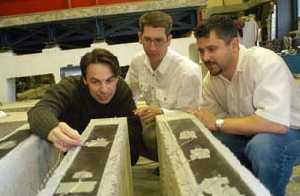 |
| Jean-Francois Trottier |
Jean-Francois Trottier, Dalhousie´s Canada Research Chair in Structural Health Monitoring and Innovative Materials, is helping to address this problem. He´s developing ingenious non-destructive methods to measure a structure´s health, so governments can use repair money wisely. He´s also making new structures stronger and more durable by researching and creating innovative materials to use in concrete.
"I don´t think many people realize just how much we depend on infrastructure, and that a lot of it is in need of repair right now", says Trottier. "In Canada alone, around $44 billion is needed to repair our bridges, tunnels and roadways. The idea of making wise decisions about repairs and making better construction materials has never been more important".
One product of his research can be found in the piers of the Mackay Bridge spanning Halifax Harbour, and in tunnels, bridges, septic tanks and concrete floors throughout the world. It´s a unique polymer fibre just a few centimetres long, resembling a giant toothbrush bristle. It´s made in Cape Breton by Trottier´s industrial partner, Atlantic Fibre Technologies. When mixed with concrete, the fibres can replace some types of steel reinforcement without any risk of rust. This can dramatically increase the lifespan of the concrete, making the structure safer and more economical.
As global demand drives up the price of steel, these fibres are proving to be very cost-efficient.
"I want to come up with new fibres that will be highly effective and good enough to replace the bulk of the steel used to reinforce concrete structures," Trottier says. To achieve this goal, he´s producing volumes of testing data that will support changes in building and design codes. Already, he´s influenced changes in Canadian design codes for septic tanks. Over 150 North American septic tank manufacturers now make their products with Trottier´s fibres instead of steel.
Trottier and his 10-person research team are also initiating a collaboration with Josef Zwanziger, a Dalhousie researcher and fellow Canada Research Chair in the Department of Chemistry. Together, they´ll create and test new fibres for different applications.
The other half of Trottier´s research is aimed at developing non-destructive structure evaluation techniques, to help determine the "health" of bridge decks, roads and similar structures. Instead of relying on visual inspection to decide which structures need repair, Trottier and his colleagues can see what´s really happening inside the concrete using a ground-penetrating radar device attached to a survey vehicle. Not only could this save lives by detecting potential flaws in a bridge, but it can also save a lot of money, by allowing engineers to better decide where to put repair resources.
Through a partnership with the University of New Brunswick and engineering firm Jacques Whitford and Associates, Trottier recently received $4 million from the Atlantic Innovation Fund, to support a four-year project to improve various non-destructive monitoring techniques.
Trottier came to Halifax in 1993 to join what is now Dalhousie´s Faculty of Engineering. Although his research is in demand throughout the world, he´s drawn by the vibrancy of the community, and the many opportunities here. "I´m offered jobs very often, but I find that I´m very well positioned here, because my industrial partner is fairly close, and I can do a lot of work with them", he says. "I see a lot of opportunities in Atlantic Canada."
